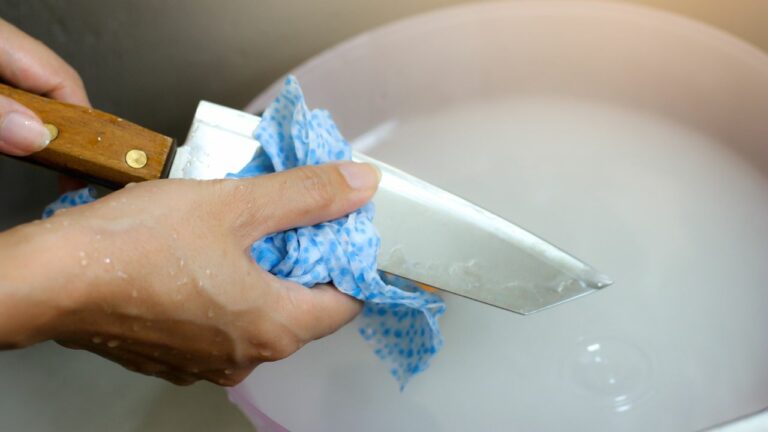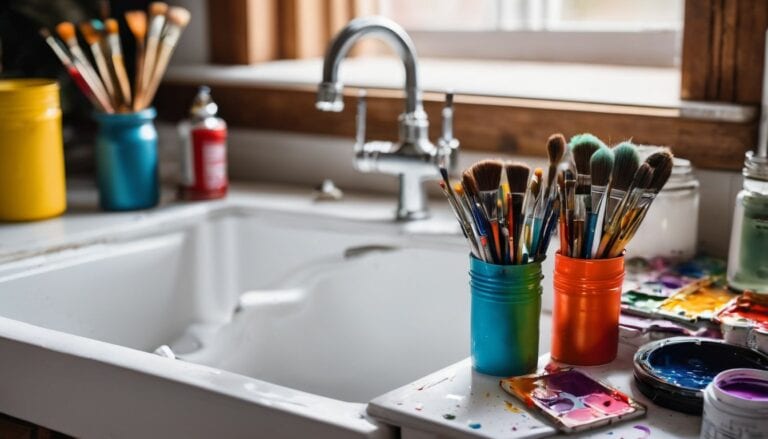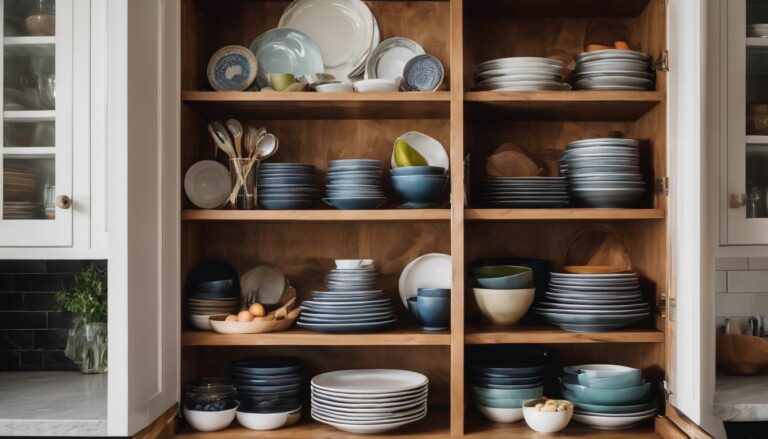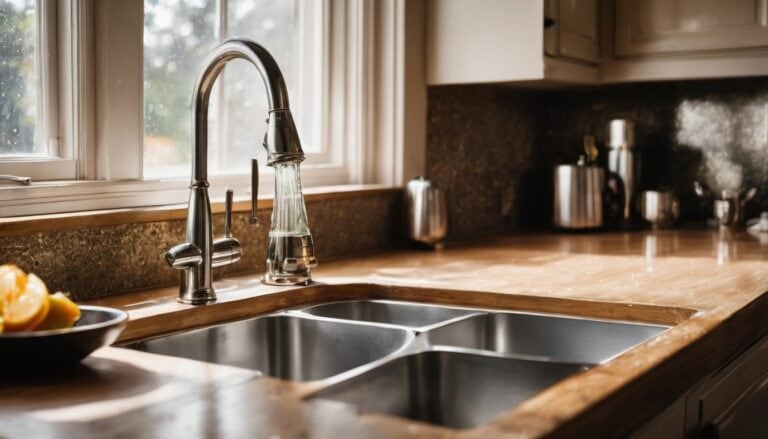Why is My Kitchen Sink Backing Up? Common Causes and Solutions
Ever caught yourself gazing at a clogged kitchen sink, pondering ‘Why is My Kitchen Sink Backing Up?’ I’m with you. Facing the constant battle with water refusing to drain is truly a hassle.
But don’t worry – I’ve rolled up my sleeves, navigated this messy issue more times than I care to count, and done some pretty intensive research along the way. So buckle up as we explore together some common causes and helpful solutions for this niggling problem—believe me; your future self will thank you!
Key Takeaways
- Common causes of a backed-up kitchen sink include clogged drain pipes, malfunctioning garbage disposals, improper installation, and debris build-up.
- Solutions for unclogging a kitchen sink include using a plunger, trying a vinegar and baking soda rinse, using boiling water, and checking the p-trap.
- Cleaning your garbage disposal regularly can help prevent backups in your kitchen sink. Simple steps like using a vinegar and baking soda mixture or scrubbing with a toothbrush can keep your disposal clean and odor-free.
- To fix a garbage disposal that’s not working properly, you can try resetting it and turning the center crank. This may help clear any jammed food particles or debris causing the issue.
Common Causes of a Backed Up Kitchen Sink

A backed up kitchen sink can be caused by several common issues such as a clogged drain pipe, malfunctioning garbage disposal, improper installation, or debris build-up.
Clogged drain pipe
A clogged drain pipe is a big problem. Small bits of food can stick together to block the pipe. If I wash more stuff down, water can’t get through. This makes the sink back up with dirty water.
It’s not just about the kitchen sink but also about other drains in the house. A blocked drain pipe may mean there’s a clog in another line, like the vent line. Be careful when using chemical cleaners though because they might hurt your pipes instead of helping them!
Malfunctioning garbage disposal
Your kitchen sink might back up if the garbage disposal isn’t working right. Clogs from food scraps and debris are often to blame. This kind of blockage makes the water drain slowly.
If it gets worse, the water can even flow back into your sink.
A blocked disposal may also affect both sinks or your dishwasher. That means there’s a big problem at hand! You need help fixing this issue so it doesn’t happen again in future.
Improper installation
A plumber must fit a kitchen sink right. If not, it can cause many problems. For example, an incorrect slope in the drain pipes may lead to water backing up into your sink. Garbage disposals also need proper fitting.
When incorrectly installed, food and waste might get stuck instead of going down the pipe. If they are loose or misaligned, leaks can happen too! So, always hire a skilled plumber for your installation tasks to avoid these troubles later on.
Debris build-up
Debris build-up in the kitchen sink happens when food scraps and soap residue accumulate over time. These particles can create blockages in the drainage system, causing water to back up.
It’s important to regularly clean your sink drain and remove any debris to prevent clogs from occurring. By taking care of your sink and disposing of waste properly, you can avoid the hassle of a backed-up kitchen sink.
Solutions for a Clogged Kitchen Sink
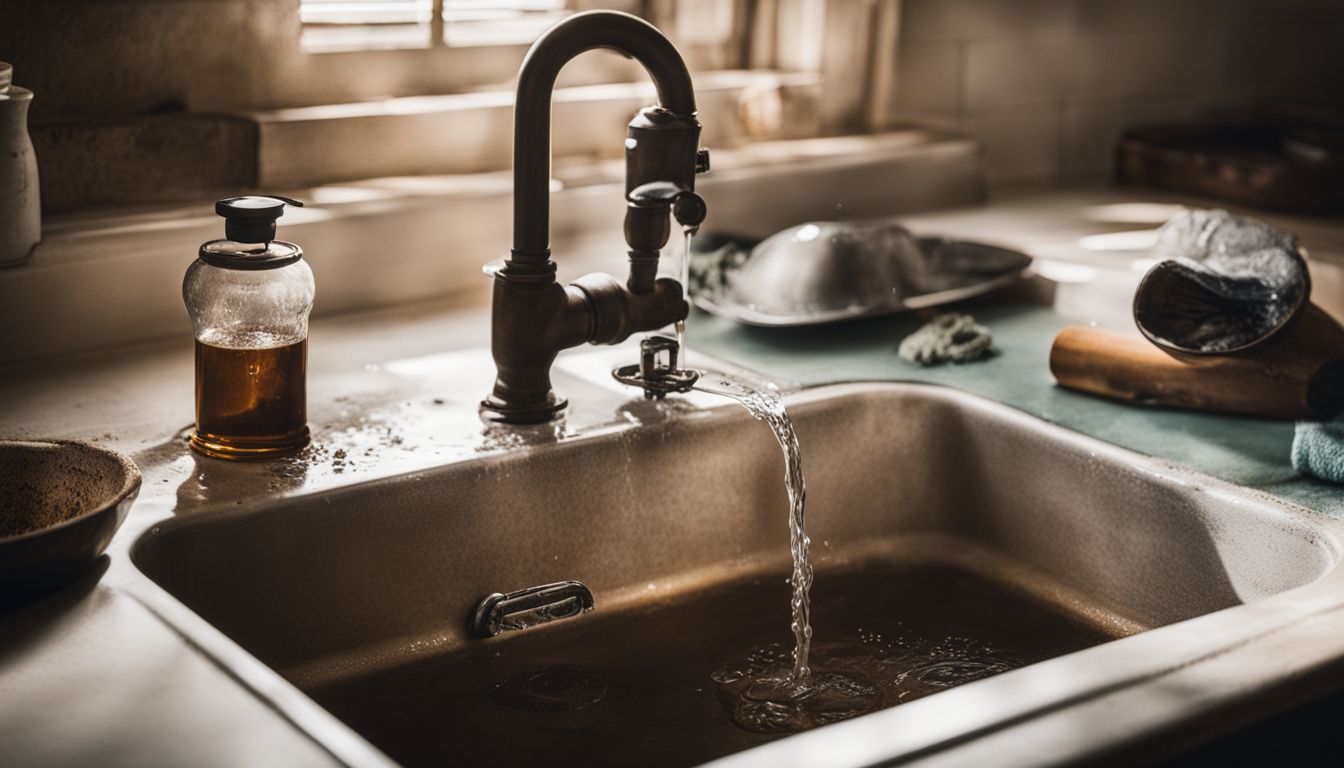
To unclog a kitchen sink, you can try using a plunger, vinegar and baking soda rinse, boiling water, or check the p-trap. Want to learn how? Keep reading!
Use a plunger
When your kitchen sink is backed up, using a plunger can be a simple and effective solution. Plungers work by creating suction to dislodge clogs in the drain pipe. To use a plunger, first make sure there is enough water in the sink to cover the rubber part of the plunger.
Place the plunger over the sink hole and firmly push down and then pull up quickly. Repeat this motion several times until you feel that the clog has been cleared. Remember to plug the opposite drain with a washcloth or rag while plunging to create better suction.
Using a plunger can help unclog your kitchen sink without needing any special tools or chemicals.
Try a vinegar and baking soda rinse
One popular and natural solution for unclogging a kitchen sink is to try a vinegar and baking soda rinse. This homemade drain cleaner can help break down mineral buildup in the pipes that may be causing the blockage.
To use this method, you simply need to pour half a cup of baking soda down the drain, followed by one cup of vinegar. Let it sit for about 15 minutes to allow the mixture to work its magic, and then run hot water down the drain to flush out any loosened debris.
Regularly using this vinegar and baking soda rinse can also help prevent future clogs from forming in your kitchen sink drains.
Use boiling water
Boiling water is a simple and effective way to unclog a backed-up kitchen sink. When poured down the drain, the hot water can help loosen and dissolve blockages caused by hair, grease, soap residue, and debris.
It’s important to note that boiling water should be used cautiously and avoid pouring it directly on porcelain sinks or PVC pipes as it may cause damage. By carefully pouring boiling water down the sink, you can break up clogs and restore proper drainage in your kitchen sink.
If this method doesn’t work, there are other solutions available to try from our list of common causes and solutions for a backed-up kitchen sink.
Check the p-trap
When your kitchen sink is backed up, checking the p-trap can help you find and resolve the problem. The P-trap is a U-shaped part of the sink’s pipe that can become clogged with food particles and grease.
To check it, start by placing a bucket under the P-trap to catch any water or debris. Then, use a wrench to loosen the fasteners holding the P-trap in place. Once it’s loose, remove it carefully and inspect for any clogs or blockages.
Clearing out the P-trap or using home remedies like vinegar and baking soda can often resolve clogs in your kitchen sink.
Cleaning Your Garbage Disposal
Cleaning your garbage disposal is an important step in preventing backups and keeping your kitchen sink working properly. Here are some simple steps you can take to clean your garbage disposal:
- Use a mixture of vinegar and baking soda: Pour half a cup of vinegar and half a cup of baking soda down the disposal. Let it sit for a few minutes, then flush it with hot water.
- Scrub with a toothbrush: Use an old toothbrush to scrub the inside of your garbage disposal. This will help remove any stuck-on food particles and keep the blades clean.
- Use ice cubes: Drop a few ice cubes down the disposal and run cold water while turning on the unit. The ice will help dislodge any debris stuck inside the disposal.
- Freshen up with citrus peels: Toss some citrus peels, like lemons or oranges, into the disposal. Run cold water and turn on the unit to help eliminate any odors.
Resetting the Garbage Disposal and Turning the Center Crank
To fix a garbage disposal that’s not working properly, you can try resetting it and turning the center crank. Here’s what you can do:
- First, make sure to turn off the power to the garbage disposal at the electrical panel.
- Look for a small red reset button on the bottom or side of the unit. Press it firmly to reset the device.
- If pressing the reset button doesn’t solve the problem, locate the center crank on the bottom of the disposal.
- Insert an Allen wrench or a hex key into the center crank and turn it clockwise and counterclockwise a few times.
- This action should help loosen any jammed food particles or debris that may be causing the issue.
Other Causes for a Backed Up Sink
A malfunctioning plumbing assembly can also be a cause for a backed up sink, as it may lead to improper water flow and drainage. Additionally, blockages in the drainage system outside of your kitchen, such as tree roots or debris build-up, can also contribute to sink backups.
Malfunctioning plumbing assembly
A malfunctioning plumbing assembly can cause your kitchen sink to back up. It happens when the pipes or other components of your plumbing system are not working properly. This could be due to a faulty pressure-reducing valve, leaky pipes, or damaged water lines.
When this happens, water may not flow smoothly through the drain and can result in a backup. If left untreated, it can lead to mold growth, foul odors, and other issues in your kitchen.
Additionally, random objects and debris can get stuck in the pipes and contribute to the clog caused by a malfunctioning plumbing assembly.
Blockages in the drainage system
One common cause of a backed-up kitchen sink is blockages in the drainage system. This happens when something gets stuck in the pipes and prevents water from flowing freely. Blockages can occur due to debris buildup, such as food scraps or other larger items that go down the drain.
When this happens, water can get trapped in the sink and not drain properly. It’s important to identify and address these blockages promptly because they can lead to damage to the sewage line or septic system if left untreated.
Regularly cleaning the drains and being mindful of what goes down them can help prevent blockages from occurring in the first place.
How to Find the Blockage
When your kitchen sink is backed up, finding the blockage is crucial to solving the problem. To locate the source of the clog, start by removing any standing water in the sink using a bucket or bowl.
Then, inspect the drain pipe for any visible debris or obstructions. If you don’t see anything there, try using a flashlight to look into the drain opening and check if you can spot any blockages further down.
You can also try running water down other drains connected to the same plumbing system to see if they are affected too, which could indicate a more serious issue with your drainage system.
By identifying where exactly the blockage is located, you’ll be able to take appropriate steps to remove it and get your kitchen sink back in working order again.
Prevention Tips for a Backed Up Kitchen Sink
To prevent your kitchen sink from backing up, avoid putting grease, oil, and food waste down the drain. Instead, dispose of them in the trash or compost bin. Use a drain cover to catch any small debris that may enter the sink and regularly clean out your garbage disposal to prevent clogs.
By practicing these simple preventative measures, you can keep your kitchen sink running smoothly and avoid future plumbing issues.
Avoid putting grease, oil, and food waste down the drain
I always make sure to avoid putting grease, oil, and food waste down the drain in my kitchen sink. It’s important because pouring these things can cause blockages and clogs in the pipes.
Leftover grease from bacon or cooking should be disposed of in a different way, like using a container or throwing it into the trash. Fats, oils, and grease (FOG) should never go down any drains or toilets as they can lead to expensive sewer pipe damage and overflows.
So remember, it’s best to dispose of grease, oil, and food waste properly to prevent any problems with your drainage system.
Use a drain cover
To prevent clogged kitchen sinks, using a drain cover is essential. This simple tool acts as a barrier, stopping debris like food scraps and hair from going down the drain. By placing a sink strainer or debris filter over the drain opening, you can catch these materials before they cause blockages in your pipes.
Cleaning out the filter regularly will ensure proper drainage and help maintain the functionality of your kitchen sink. So don’t forget to use a drain cover to keep your sink free from clogs and ensure smooth water flow.
Regularly clean the garbage disposal
To keep your kitchen sink from backing up, it’s important to regularly clean the garbage disposal. By maintaining a regular cleaning schedule for your garbage disposal, you can prevent clogs and backups in the kitchen sink.
One easy way to unclog a garbage disposal is by using ice cubes – simply run them through the disposal to break up any debris that may have built up. Regularly cleaning the garbage disposal also helps prevent clogs caused by grease and fats, keeping your sink clear and flowing smoothly.
In addition, regular maintenance and cleaning of the garbage disposal will help avoid any interference with your regular kitchen cleaning routine. By taking these simple steps, you can ensure that water doesn’t back up into other sinks or even your dishwasher.
When to Call a Professional Plumber
If you’ve tried everything to fix your backed up kitchen sink, but nothing seems to work, it’s time to call a professional plumber. They have the experience and tools to handle even the toughest clogs.
You should also consider calling a plumber if you’re experiencing frequent backups or if your attempts to clear the clog are only temporary solutions. Another reason to call a plumber is if there are multiple drains in your home that are backing up at the same time.
This could be a sign of a more serious plumbing issue that needs professional attention. Remember, it’s better to call a plumber sooner rather than later to prevent further damage and costly repairs.
In conclusion, a backed-up kitchen sink can be caused by various factors such as clogged pipes, malfunctioning garbage disposals, or improper installation. To unclog the sink, you can try using a plunger or a vinegar and baking soda rinse.
It’s important to prevent clogs by avoiding putting grease, oil, and food waste down the drain. If the problem persists, it may be necessary to call a professional plumber for assistance.
Keep your kitchen sink clean and clear to avoid future backups.
FAQs
What are the common causes of a kitchen sink backing up?
The common causes of a kitchen sink backing up include clogs in the drainpipe, buildup of grease or food debris, and problems with the plumbing vent system.
How can I prevent my kitchen sink from backing up?
You can prevent your kitchen sink from backing up by avoiding pouring grease and oil down the drain, using a drain strainer to catch food particles, and regularly cleaning your pipes with hot water and baking soda.
Can I fix a backed-up kitchen sink myself?
Yes, you can try fixing a backed-up kitchen sink yourself by using a plunger or a drain snake to remove the clog. If these methods don’t work, it’s best to call a professional plumber for assistance.
Why is there an unpleasant odor coming from my backed-up kitchen sink?
An unpleasant odor coming from your backed-up kitchen sink may be due to trapped food debris or stagnant water in the pipes. Cleaning the pipes using vinegar and baking soda or contacting a plumber for thorough cleaning can help eliminate the odor.
What should I do if my efforts to fix a backed-up kitchen sink are unsuccessful?
If your attempts to fix a backed-up kitchen sink are unsuccessful, it’s recommended to contact a professional plumber who has specialized tools and expertise to identify and resolve more complex issues causing the backup.
How do you fix a kitchen sink that is backing up?
To fix a backed-up kitchen sink, start by using a plunger to dislodge any blockage. If that doesn’t work, use a plumber’s snake to break up the clog. For persistent issues, remove and clean the P-trap. Always wear gloves and have a bucket ready for any water that may spill out.
What would cause a kitchen sink to back up?
A kitchen sink can back up due to accumulated grease, food particles, soap scum, or foreign objects that shouldn’t be disposed of down the sink. Over time, these can form a clog, restricting water flow.
Why is my sink backing up with no clog?
If your sink is backing up without a visible clog, it could be due to a blockage in the main sewer line, venting issues, or buildup in the pipes that isn’t easily seen. It’s essential to investigate further to identify and resolve the underlying problem.
Why you should never use baking soda and vinegar to unclog a drain?
While baking soda and vinegar can sometimes clear minor clogs, they can also cause issues by creating a hardened mass in the pipes. Additionally, the chemical reaction can damage PVC pipes and the seals in your plumbing system.
Can you pour Drano down the kitchen sink?
Drano can be poured down a kitchen sink to address clogs. However, it should be used as directed and sparingly, as overuse can lead to pipe damage. It’s not suitable for use in completely blocked drains or if you have a garbage disposal.
How do you unclog a severely clogged drain?
For severely clogged drains, a multi-step approach is often necessary. Start with a plunger, followed by a plumber’s snake or auger. If these methods don’t work, a chemical drain cleaner can be used as a last resort, or you may need to call a professional plumber.
What does a plumber do to unclog a kitchen sink?
Plumbers typically start with manual tools like a plunger or a plumber’s snake to dislodge clogs. If these don’t work, they may use a hydro jetting machine or remove sections of piping to directly access and remove the blockage.
Why do plumbers say not to use Drano?
Plumbers often advise against using Drano because it contains harsh chemicals that can corrode pipes over time. It can also worsen clogs and pose a hazard to the plumber who may need to work on the pipes afterward.
What can I pour down my sink to unblock it?
To unblock a sink, you can pour a mixture of hot water and dish soap down the drain or use a plunger. Baking soda followed by vinegar can also be effective for minor blockages, but should be used with caution.
What’s the best clog remover?
The best clog remover depends on the type of clog. For organic material, enzymatic cleaners are effective and safe for pipes. For tougher clogs, a mechanical tool like a plumber’s snake or a high-quality chemical cleaner may be necessary.
What is the quickest way to unblock a drain?
The quickest way to unblock a drain is often using a plunger to create pressure that dislodges the clog. If that doesn’t work, a plumber’s snake can be used to reach deeper into the pipes.
What breaks up a clogged drain?
To break up a clogged drain, use a plunger first. If unsuccessful, apply a drain cleaner that can dissolve the clog or use a plumber’s snake to physically break it apart. Hot water can also help to melt grease that may be causing the blockage.


